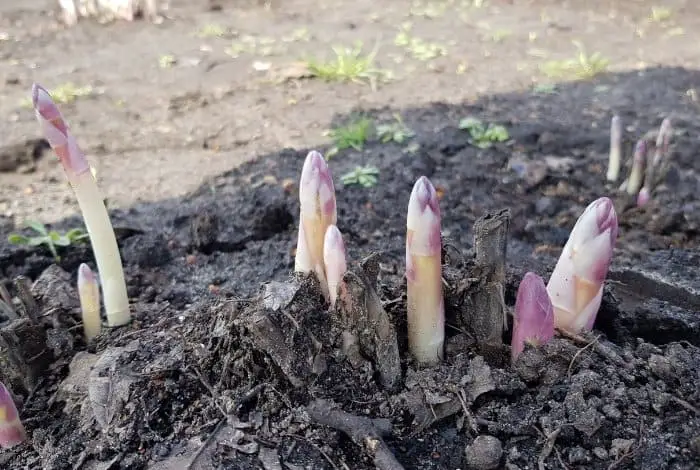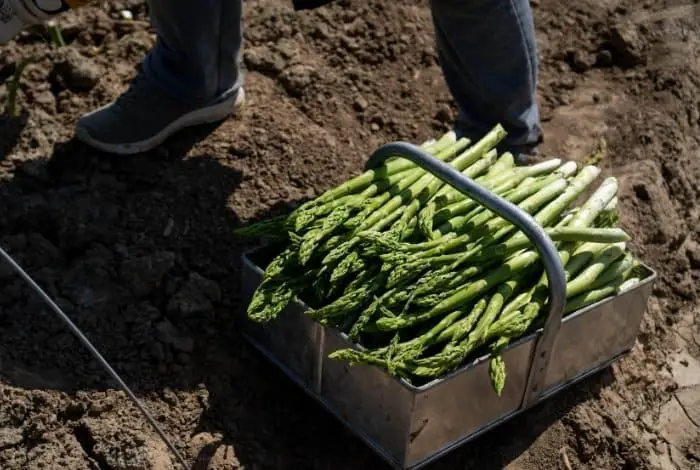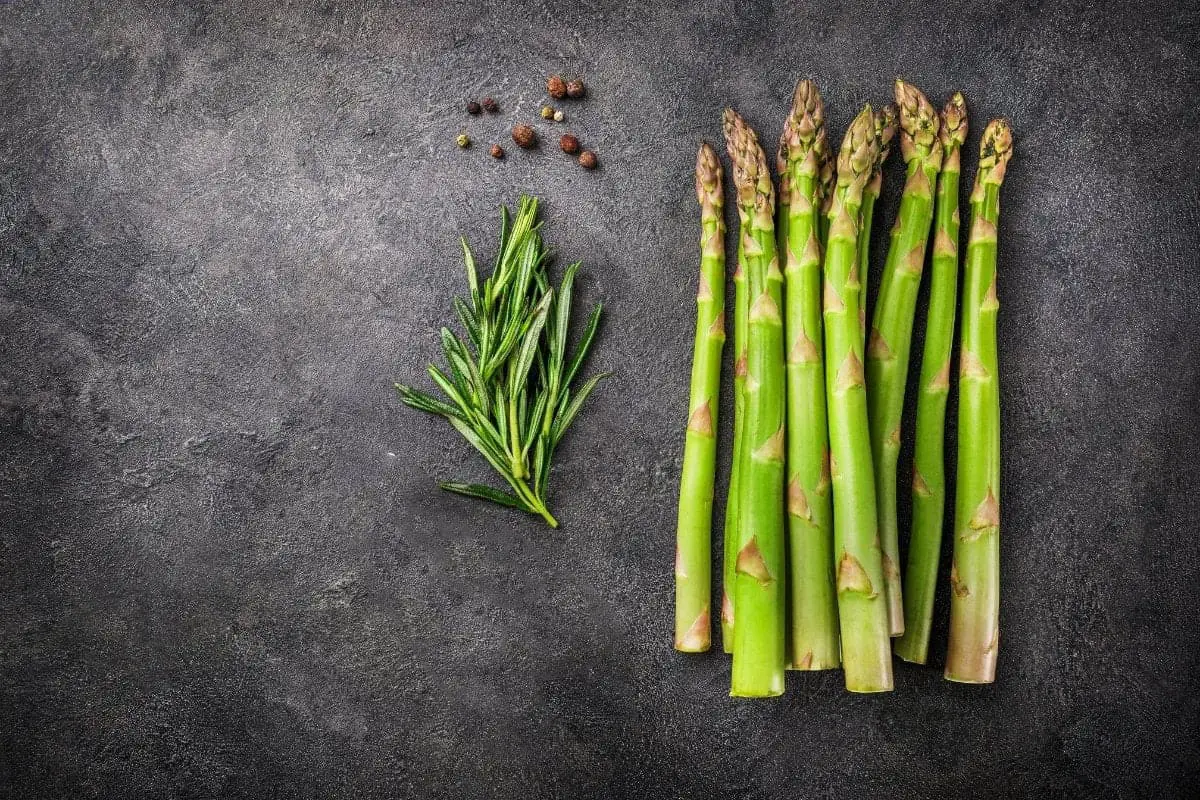Last Updated on January 7, 2023 by Urska
Growing asparagus from seedlings is easy and it will save you time allowing you to harvest-ready asparagus a season earlier.
Asparagus has a unique texture and flavor that evokes strong feelings from people. Most asparagus lovers enjoy eating them when in season beginning early May through Mid-June. It does not freeze well so you can only enjoy it when it’s in season.
The best thing about asparagus is how easy it is to grow them from seedlings. Asparagus is a perennial plant that remains productive for 10 years or more from its initial planting date.
Growing Asparagus From Seedlings?
Starting
Asparagus seedlings are known as crows. These are transplants that are 2 years old and are grown for the sole purpose of selling them at the crown stage.
It is faster to grow asparagus from crowns than it is to grow them from seeds. Crowns withstand cold weather but they need to be planted as soon as they are delivered.
If the season is too frosty or the soil is frozen, you can plant them in a container and keep them in a cold but well-protected place like a garden shed or garage.
Preparing
Soil preparation is vital to long-term productivity. Once the frost season has ended and the soils warmed up, dig the planting area deeply and mix it with organic matter like compost or well-rotted manure.
Add a generous amount of glacial rock to give your soil the required mineral content. Space your asparagus seedlings at a minimum of 18 to 24 inches between plants and 5 inches apart for the rows. Add a slow-release fertilizer before transplanting that will feed your plants for a longer period of time.
Transplanting Is Critical!
Asparagus is a deeply rooted perennial, which means the roots can penetrate very deep. If your soils are heavy, it’s best to plant the crows at a depth of 4 inches but in well-drained soils, you can plant the tip of the crown at a depth of 8 inches or more.

You can choose to either use the trench method or individual holes that are all perfect for transplanting. Once transplanted, fill the hole in as the fronds grow taller. You can now sit back and allow them to grow ready for harvest in the same year you plant the seedlings.
Growing
The best strategy you can work with your asparagus is to allow them to become well established before harvesting. If you chose to grow yours from seeds, this means you will have to wait for 2 years before the first harvest. But if you choose asparagus seedlings (crowns) then it’s possible to harvest a year after planting.
But in order to allow your asparagus to be well established, do not harvest them in the first year, rather allow them to grow and become strong. Do not be tempted to harvest the stalks in the first year; your patience will be rewarded in year two.
Harvesting
Once you have allowed your plants to establish themselves for a second year, go ahead and enjoy the bountiful harvest. Harvest your asparagus over a 2 to 3 week period.

Cut the fattest spears off at ground level when they are 6 to 10 long. Allow the thinner spears to grow into big fronds to nourish the roots. Each year, the harvest lengthens to a maximum of 6 to 8 weeks allowing you to enjoy more harvest.
Store your harvested asparagus in the refrigerator wrapped in a damp paper towel for several days. Freezing or canning asparagus is not possible so enjoy them when fresh.
Pests And Diseases
Asparagus is affected by pests that include beetles and cutworms that you can handpick and remove. Diseases like fusarium crown rot, and asparagus rust, affect these plants but can be managed and controlled by using friendly methods like avoiding excessive watering and harvesting, destroying infected plants, ensuing their s proper circulation of air in your garden, and many others.
Encourage beneficial insects like ladybugs that help control and eliminate aphids. Also, plant companion plants reduce the need to use pesticides. Plant asparagus together with basil, cilantro, oregano, parsley, and peppers.
Bonide 811 Copper 4E Fungicide 16oz (473ML)
FAQs
When is the best time to grow Asparagus from seed?
Asparagus is a vegetable that needs very specific conditions to grow successfully. It takes about three months from seed to harvest. Growing Asparagus from Seed Asparagus grows best in cool weather.
In most parts of the country, it’s too hot in the summertime for asparagus to germinate. In the Midwest and Northeast, asparagus can be planted in spring or fall. In the Northwest, it’s much too cold in the winter for asparagus to germinate. You will need to start your seeds indoors.
Can you plant Asparagus seeds in the ground?
If you live in an area that is not particularly warm or cold, you can choose to start asparagus seeds directly in the ground. Asparagus plants are a perennial. They come back year after year. You can divide them every two years or so.
When should you transplant your asparagus from seed?
Asparagus is an easy plant to grow. As soon as the first true leaves appear, transplant the seedlings to individual pots and grow them in a sunny spot. You can check on the size of your plants by lifting up one of the leaves and seeing how it fits in your hand.
If they are too big, then it’s time to start taking care of them and you will want to cut them back. The best way to keep the size of your garden down is to have a good compost system. You can also make a good compost pile in your yard.
Does asparagus need full sun?
Yes. It needs the sun to produce its own vitamin D, and this is only possible in direct sunlight, at least for a few hours each day. What about shade? If you are growing asparagus in a greenhouse or protected area, then it can be grown under trees or buildings, but it won’t get enough sunlight. Asparagus is a very forgiving vegetable.
What kind of soil should you plant them in?
Asparagus plants grow best in well drained soil. If you have heavy clay soil, you may need to amend your soil with organic material like peat moss.
How do they grow?
Asparagus is a perennial herbaceous plant that grows from rhizomes. Each plant has two sets of leaves, one on the top and one on the bottom. The top leaves are called crowns, and they grow out of the crowns. The bottom leaves are called stolons, and they grow down into the soil and can be more than 15 feet long.
Conclusion
FAQs
When is the best time to grow Asparagus from seed?
Asparagus is a vegetable that needs very specific conditions to grow successfully. It takes about three months from seed to harvest. Growing Asparagus from Seed Asparagus grows best in cool weather.
In most parts of the country, it’s too hot in the summertime for asparagus to germinate. In the Midwest and Northeast, asparagus can be planted in spring or fall. In the Northwest, it’s much too cold in the winter for asparagus to germinate. You will need to start your seeds indoors.
Can you plant Asparagus seeds in the ground?
If you live in an area that is not particularly warm or cold, you can choose to start asparagus seeds directly in the ground. Asparagus plants are a perennial. They come back year after year. You can divide them every two years or so.
When should you transplant your asparagus from seed?
Asparagus is an easy plant to grow. As soon as the first true leaves appear, transplant the seedlings to individual pots and grow them in a sunny spot. You can check on the size of your plants by lifting up one of the leaves and seeing how it fits in your hand.
If they are too big, then it’s time to start taking care of them and you will want to cut them back. The best way to keep the size of your garden down is to have a good compost system. You can also make a good compost pile in your yard.
Does asparagus need full sun?
Yes. It needs the sun to produce its own vitamin D, and this is only possible in direct sunlight, at least for a few hours each day. What about shade? If you are growing asparagus in a greenhouse or protected area, then it can be grown under trees or buildings, but it won’t get enough sunlight. Asparagus is a very forgiving vegetable.
What kind of soil should you plant them in?
Asparagus plants grow best in well drained soil. If you have heavy clay soil, you may need to amend your soil with organic material like peat moss.
How do they grow?
Asparagus is a perennial herbaceous plant that grows from rhizomes. Each plant has two sets of leaves, one on the top and one on the bottom. The top leaves are called crowns, and they grow out of the crowns. The bottom leaves are called stolons, and they grow down into the soil and can be more than 15 feet long.
We have learned how easy growing asparagus from seedlings is let’s learn one more thing. Asparagus comes either in males or females. Female plants produce berries and males do not, so they grow faster than females. For this reason, growing male asparagus plants is often preferred.
You also choose to grow green, white, or purple asparagus. White asparagus is not a variety rather it’s the normal green asparagus grown in the absence of sunlight to prevent chlorophyll from developing. It is commonly loved as it is sweeter than the green asparagus but it has less fiber.
Purple asparagus is a breed on its own. It’s purple in color but turns green when cooked. This variety tends to have thicker spears but fewer pieces.
Now you can go ahead and choose which one to grow and enjoy its fresh produce!
Caroline is a gardener who loves to get down to the nitty–gritty of gardening. She proudly proclaims herself as a ‘dirt worshipper‘ and can often be found deep in the garden, covered in soil and singing to her plants. As a self–proclaimed ‘plant whisperer‘, Caroline believes that plants need love and attention just like any other living thing, and she loves to give them both. When she‘s not tending to her garden, you can often find her researching the latest gardening trends, or teaching others how to make their gardens thrive



